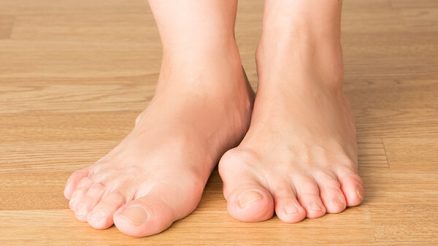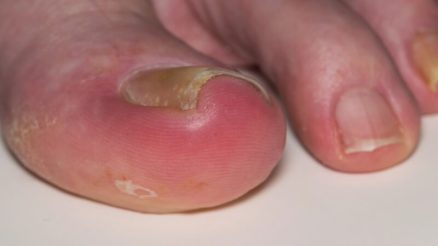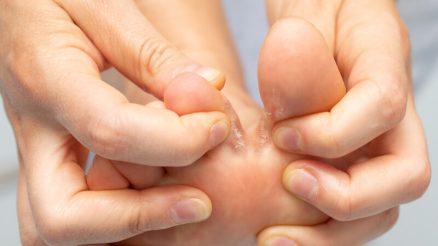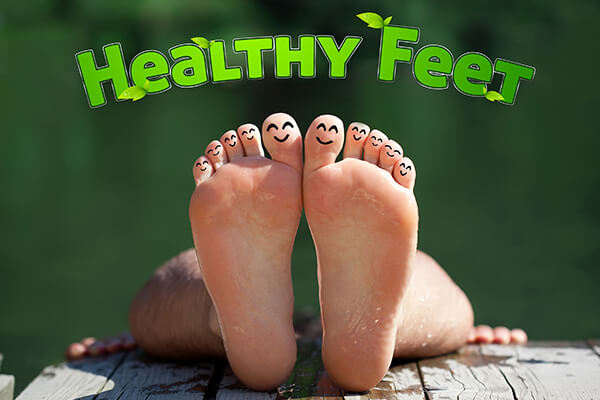
Your feet go through a lot of torture every single day from standing, walking, or running around. This can often lead to pain, aches, and cracks. Worst case scenario, several infections. Despite the risks, we hardly pay as much attention to them as we do to our faces and other body parts. Foot health is just as important if we have to keep moving. They too need some tender, loving care; so a good foot care routine is equally essential. Here are certain ways to keep your feet healthy:
30 Tips to Keep Your Feet Healthy:
1. Check your feet every day
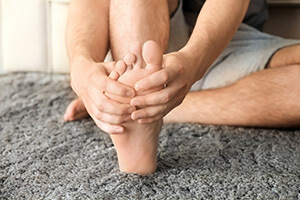
One of the simplest ways to ensure good foot health is a daily check-up. This assessment checks for any abnormalities which could be treated if detected early. In particular, you need to look out for cuts, sores, dry cracks, any changes in color or temperature, rashes, swelling or any bruises. All these could be signs of a foot infection or underlying condition. People with diabetes should especially check for any abnormal symptoms as they are highly susceptible to foot problems.
2. Wash your feet in warm water
According to research, having a warm water foot bath loosens your joints and stimulates blood flow to the stiff muscles. It also reduces pain and is enhances relaxation. A mild soap should be used, and the washing should be done gently. Worth noting is that the water used should be lukewarm and not hot. The temperatures should range between 92 and 100 degrees Fahrenheit. Water temperature that is extremely high is considered dangerous for anyone.
3. Soak your feet
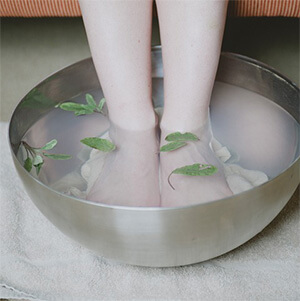
Soaking the feet for about 20 minutes in warm water has been reported to be emotionally, mentally and physically therapeutic. Magnesium sulfate crystals, better known as Epsom salts, can be added to the water. These salts boost magnesium levels in the body, even up to 35% improving the overall bone and heart health. Essential oils such as lavender, tea tree oils, or lemon juices also work well in this regimen as well. The foot soak remedy is however not recommended for diabetic patients as it can result in pain or inflammation causing more harm (especially when using the Epsom salts).
4. Exfoliate and scrub
Exfoliation and scrubbing both work well to remove dead skin from the feet. Usually, gels or creams are applied on the feet. They work by either peeling or scrubbing off the dead skin. Those used for scrubbing will typically have a gritty texture. Always make sure you use products that go well with your skin to prevent any irritations. If done the right way, this foot care routine will help put down any foot problems or infections that result from clogged up pores.
5. Dry your feet well and between your toes
It goes without saying that many foot infections, and especially fungal ones, arise from improperly drying your feet. After washing your feet, it is vital that you dry them thoroughly and especially in between the toes. Using powder will also help a great deal, not only in keeping your feet dry but also in preventing foot odor. If you love to wear socks, ensure they are moisture wicking socks to keep away moisture from the skin of your feet.
6. Keep the skin soft and smooth
Feet will usually crack if not well cared for. To prevent this, simple routines such as soaking, washing, scrubbing and moisturizing the feet should be conducted regularly. Visiting a spa and going for a pedicure once in a while will also do your feet some good and keep them smooth and soft.
7. Gently rub calluses with a pumice stone
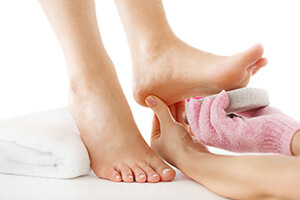
Calluses are pretty much harmless, but that doesn’t mean they should stay. This hard skin on the feet can be very painful, especially when you have to stand or walk. One way of getting rid of them is by using a pumice stone. You can do this after soaking your feet in water for about 10 minutes. After the calluses get softened, the pumice stone is gently rubbed on the bump, followed by some lotion to lock in moisture.
8. Trim your toenails regularly
Failure to trim your nails increases the probability of having ingrown toenails. These cause a lot pain, discomfort, and possible infection. To avoid this, have your toenails clipped regularly. Use appropriate nail clippers for the trimming and do it straight across instead of in a curved manner. Also, do not cut the nails too short as this makes your nail vulnerable to infections and can also be painful.
9. Avoid Going barefoot
Most swimming pools will not allow you to have regular shoes on the pool deck and this may tempt you to walk barefoot. However, the dampness on the tiles of the deck may not be suitable for your bare feet. This is because it is good ground for microorganisms. It is therefore recommended that you wear sandals to protect your feet. This also applies to the locker room, your backyard, and the beach. You should make a habit of wearing flip flops inside the house as the hard floor can dry out the skin and even cause cracking.
10. Wear the right and proper fit shoes
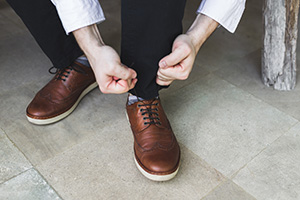
Wearing shoes with an improper fit is likely to result in bunions, corns, and foot deformities. When buying shoes, it is important to ensure your toes are not cramped. The shoes should be able to fit you perfectly and even allow for a little bit of space to prevent any of the foot problems. For added comfort, you can also add a cushioned insole for shoes with removable insoles.
11. Change the shoes you wear every day
Throughout the day, your feet sweat a lot. It is advisable to let shoes get some fresh air before wearing them again. This would most likely mean alternating them on a daily basis. The moisture or dampness in shoes can lead to the growth of fungi in the feet, causing subsequent infections.
12. Always wear clean socks with your shoes
Socks play a big role in foot health. One, they provide warmth during cold seasons and offer protection from conditions that arise from the cold such as frostbite or hypothermia. Socks made of materials that readily absorb sweat and moisture are your best bet at preventing fungal infections. Socks also generally provide an excellent cushioning, preventing cracking of the feet and keeping them soft.
13. Change your socks every day
Socks, just like shoes also accumulate sweat. This provides a good environment for the growth of fungus. Therefore, wearing socks repeatedly without changing or washing could result in infections such as athlete’s foot among others.
14. Keep the blood flowing to your feet
Proper blood circulation is crucial for the overall health of the body, not the feet. Common health conditions that are associated with reduced blood flow include hypertension, diabetes, and varicose vein. Blood circulation can be improved by doing regular exercises for the feet such as climbing the stairs, walking, running, or even swimming. Also, having warm water therapy frequently helps to rejuvenate the feet allowing for proper flow.
15. Stop smoking to improve blood circulation

Carbon dioxide from tobacco damages a vital layer of cells in the blood vessels which are responsible for smooth blood flow. This often leads to accumulation of fats and plaques on the walls of the vessels and disrupting circulation. Smoking should be avoided at all costs to improve blood circulation and to keep your feet and overall body, healthy.
16. Manage your diabetes to prevent foot problems
For people with diabetes, foot problems are quite common. The condition may present itself with other issues such as poor blood circulation and nerve damage. Reduced blood flow results in sores that take longer to heal or that do not heal at all. Nerve damage, on the other hand, may mean the loss of sensation and so you may not feel any pain even after being pricked under your feet. What is important is to manage diabetes by controlling glucose levels and having regular check-ups. Overall, this reduces the chances of having foot problems.
17. Ease Sweaty Feet
Excessive sweating, also known as hyperhidrosis is a condition which could result in foot infections and foot odor. You can prevent this by maintaining a proper foot care routine. This involves washing your feet daily and drying them appropriately. Wearing wicking socks made from acrylic or natural material also works by keeping moisture away from your feet. Another way to ease the sweating is by using antiperspirants or talcum powder which will keep your feet dry. In the event, the sweating is too much and does not cease, you should see a doctor.
18. Maintain a healthy weight
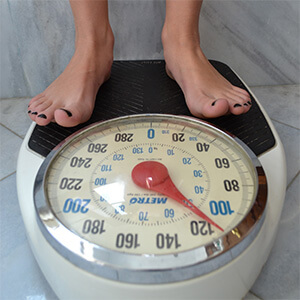
Being overweight largely contributes to foot health. It greatly influences problems such as arthritis or heel pain. It also increases the chance of conditions such as atherosclerosis, high blood pressure, and diabetes. This will often lead to poor blood circulation. Therefore, to prevent this, you should exercise frequently and watch how you eat.
19. Eat Right for Your Foot
Nutrition plays an important role in the health of your feet. Conditions such as osteoporosis (bone disease), may manifest its first symptoms at the feet. Such conditions can be prevented if you eat a balanced diet. Introducing dairy products in your diet containing calcium and vitamin D will help in keeping your bones healthy. You should also reduce on foods such as refined grains and sugars that lead to tissue inflammation.
20. Keep your feet well hydrated
Your feet should stay moisturized just like any other part of the body. Without being hydrated, they become dry, rough and crack easily. You can prevent this by using lotions and creams that keep the skin hydrated. Some moisturizers have also been shown to treat dry skin conditions such as eczema.
21. Avoid Pedicure Risks At Nail Salons
Occasionally, you will find yourself going for a pedicure at a nail salon. Exercise caution to prevent contracting any infections. You can do this by for example carrying your tools, and this is as the tools used at the salons may not be sterilized. If you must get your feet soaked, ensure the soaker tub that will be used has a plastic liner. You may also just opt for a dry pedicure that does not involve using water. For those with compromised immune systems, avoid going for the pedicure altogether.
22. Avoid sharing footgear
This mostly includes shoes and socks. Many people have foot infections that are contagious. The most common way of passing the infection is through sharing of socks and shoes. So they unknowingly spread from one person to another. Fungi and other microorganisms thrive well in wet and damp conditions. Footwear thereby meets the ideal environment for that.
23. Regular foot massages and Reflexology
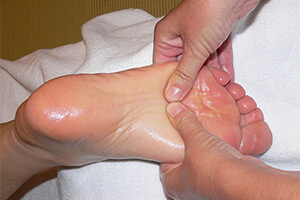
Reflexology involves applying certain pressure technique to specific reflex points on the feet such as ankles, soles, and toes. Foot massaging works on the soft tissues of the feet and has the same effect as reflexology. Both cause relaxation, improve blood flow and help in reducing pains and aches. Certain oils are also used to enhance the soothing process. With foot massages and reflexology, you promote the overall health of your feet.
24. Stretch your feet to relieve foot pain
To relieve pain in the foot such as Plantar Fasciitis, which is basically heel pain, you can practice stretching your feet. For instance, do the towel stretch which involves sitting up in bed with both legs straight. A loop rolled-up towel or an exercise band is put beneath one foot. From there, you pull the towel toward you and then hold for a few seconds before exchanging the feet. This is repeatedly done. The stretches work by loosening the muscles and promoting elasticity and healing.
25. Exercise your toes and feet
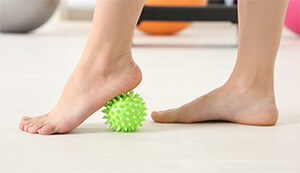
Your toes and feet also require frequent exercises to stay healthy. Regular exercise for your feet to improve the range of motion and can therefore help reduce your chances of getting hurt. You can do simple routines such as toe raises, point, and curl, marble picking among others from the comfort of your home. These go a long way in making your feet healthier.
26. Be more physically active
Being more physically active means engaging in activities such as running, walking, working out at the gym, etc. The exercises not only reduce the chances of lifestyle diseases such as diabetes but they also strengthen bones. Lower limb exercises also keep the feet muscles loose, ultimately decreasing the risk of injuries.
27. Don’t forget the sunscreen
As you apply sunscreen on your face during summer, remember your feet as well. The skin on your feet is equally susceptible to cancers such as melanoma. It is therefore essential to apply the sunscreen cream on your feet to prevent this. Especially in locations such as the pool or at the beach where your feet are exposed to direct sunlight.
28. Wear flip-flops cautiously
Despite flip-flops being good footwear, especially on a hot sunny day, they also present some fair amount of problems. For one, the rubber sole is usually quite thin, and this can cause excessive foot pressure and pain. The thong that rests between the toes can also cause friction which leads to blisters. Besides that, they offer little protection to the feet since they are open and this can create room for microorganisms. They should therefore be worn cautiously and not for a extended periods of time.
29. Ask your doctor to check your feet at every visit
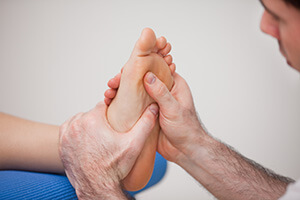
As you visit your doctor for any other reason, it is the best time to have your feet checked; killing two birds with one stone. The doctor will examine your feet for any problems and recommend treatment, if need be, as early as possible.
30. See your podiatrist if the pain persists
In case of any persisting pain, even after doing some home foot care routine, it would only be wise to see your podiatrist. They are in a better position to make a diagnosis and treat the condition.
Conclusion
Some of the foot problems may be hard to treat and others may even require surgery. Keeping your feet healthy in simple ways such as these go a long way in preventing any diseases and leaves you with happy feet. The value of good health, in all areas of our bodies cannot be underestimated. Establish a regimen that works for you and do it consistently. It is the only guarantee for good results. Don’t forget to follow a good diet and exercise.





